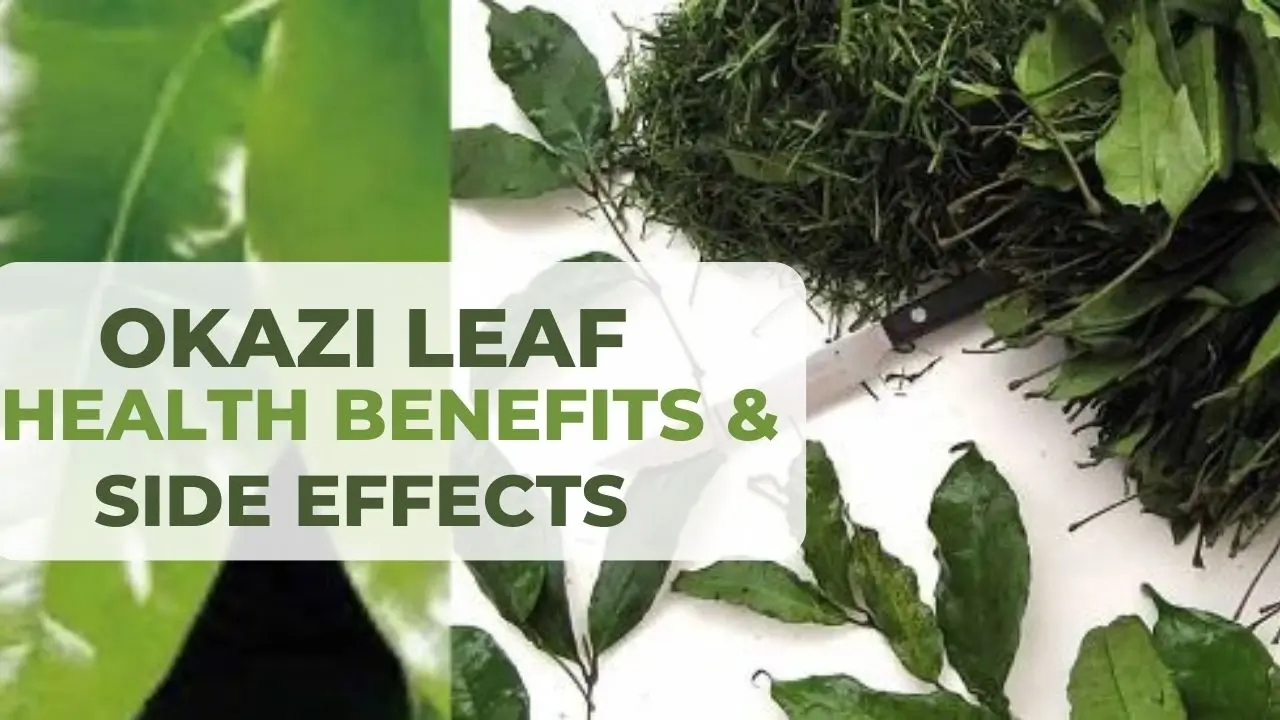
Okazi leaf, also known as wild spinach, afang, eru, or ukazi, is a dark green leafy vegetable belonging to the Gnetaceae family. It is a climbing plant that grows in the tropical regions of Africa, especially in Nigeria, Cameroon, DR Congo, Gabon, Angola, Asia, and South America. It is widely used to prepare various soups and stews, such as afang soup, ukazi soup, ukase and m’fumbua. It has a slightly bitter taste and a tough texture that requires prolonged cooking or pounding before consumption.
In this article, we will explore the health benefits and side effects of okazi leaf and how to use and preserve it. Without further ado, let’s dive in!
What is Okazi Leaf?
Okazi leaf is the name given to the leaves of a plant called Gnetum africanum. It is a perennial vine that can grow very long. The leaves are simple, opposite, elliptic, or ovate, with entire margins and a pointed tip.
Okazi leaf is rich in nutrients such as carbohydrates, protein, fibre, fat, calcium, magnesium, iron, zinc, aspartic acid, cysteine, and proline. It also contains phytochemicals, such as flavonoids, phenols, tannins, and saponins. These compounds have antioxidant, anti-inflammatory, anti-cancer, and antimicrobial properties.
History & Origin of Okazi Leaf
Okazi leaf has been used for centuries by the people of Africa as food and medicine. It is believed to have originated in the Congo basin and spread to other parts of the continent through trade and migration. It is also found in some parts of Asia and South America, where enslaved Africans or traders introduced it.
Okazi leaf is essential in many traditional African dishes, especially in Nigeria, Cameroon, Gabon, and the DR Congo. It is used to make soups that are eaten with staples like fufu, garri, pounded yam, or rice. Some of the popular dishes that use okazi leaf are:
- Afang soup: a soup made with okazi leaf (afang in Efik or Ibibio), waterleaf (Talinum triangulare), palm oil, meat or fish, crayfish, periwinkle, and seasoning. It is a delicacy in southeastern Nigeria and some parts of Cameroon.
- M’fumbua: A soup made with okazi leaf (called m’fumbua or fumbua in Lingala), palm oil, meat or fish, onion, garlic, tomato, and seasoning. It is a staple food in the Democratic Republic of Congo.
Health Benefits of Okazi Leaf
Okazi leaf has many health benefits thanks to its nutritional and phytochemical composition. Some of the health benefits of Ukazi leaf are:
Okazi Leaf for Weight Loss
Okazi leaf is a good source of dietary fibre, which can help to reduce appetite, increase satiety, and prevent overeating. Fibre also helps to regulate blood sugar levels, lower cholesterol levels, and improve digestion. Ukazi leaf is also low in calories and fat, making it a suitable addition to a weight-loss diet.
Okazi Leaf for Fertility
Ukazi leaf is rich in iron, zinc, and vitamin C, essential for producing quality sperm and eggs. Iron helps to prevent anaemia, which can affect fertility in both men and women. Zinc helps boost testosterone levels, sperm count, and motility in men, as well as ovulation and implantation in women. Vitamin C helps to protect the sperm and eggs from oxidative stress and improve their viability.
Ukazi leaf also contains phytoestrogens, which are plant compounds that mimic the effects of oestrogen in the body. Phytoestrogens can help to balance hormones, regulate menstrual cycles, and enhance fertility in women with low oestrogen levels.
Okazi Leaf for Skin & Hair
The leaf is rich in antioxidants, such as flavonoids, phenols, and vitamin C, which can help protect the skin and hair from free radical damage, inflammation, and ageing. Antioxidants can also help to improve skin elasticity, collagen synthesis, wound healing, and skin tone.
Ukazi leaf also contains protein, which is the building block of keratin, the main component of hair. Protein can help to strengthen hair follicles, prevent hair loss, and promote hair growth.
Ukazi Leaf for Diabetes
Ukazi leaf is suitable for people with diabetes, as it can help to lower blood sugar levels and improve insulin sensitivity. Ukazi leaf contains fibre, which can slow down glucose absorption into the bloodstream and prevent spikes and crashes in blood sugar levels. Fibre can also help reduce insulin resistance, a condition where the cells do not respond well to insulin, the hormone that regulates blood sugar levels.
Okazi also contains phytochemicals, such as flavonoids and saponins, which can modulate the activity of enzymes involved in carbohydrate metabolism, such as alpha-amylase and alpha-glucosidase. These enzymes break down starches and sugars into glucose, raising blood sugar levels. By inhibiting these enzymes, the leaf can reduce the amount of glucose that enters the bloodstream after a meal.
Okazi Leaf for Hypertension
Ukazi leaf is helpful for people with hypertension or high blood pressure, as it can help lower blood pressure levels and prevent cardiovascular complications. It contains potassium, magnesium, and calcium, which are minerals that play essential roles in regulating blood pressure. Potassium helps to balance sodium levels in the body and relax blood vessels. Magnesium helps to dilate blood vessels and improve blood flow. Calcium helps to contract blood vessels and maintain a normal heart rhythm.
The leaves also contain phytochemicals, such as flavonoids and saponins, which can act as natural diuretics, increasing urine output and reducing fluid retention in the body. This can help lower blood pressure by reducing blood volume and pressure on the blood vessel walls.
Okazi Leaf for Cancer
Ukazi leaf has anticancer properties, as it can help to prevent or inhibit the growth and spread of cancer cells. The leaf contains antioxidants, such as flavonoids, phenols, and vitamin C, which can scavenge free radicals that cause DNA damage and mutation in cells. Antioxidants can also modulate the expression of genes involved in cell cycle regulation, apoptosis (programmed cell death), angiogenesis (blood vessel formation), and metastasis (cancer spread).
The leaf also contains phytochemicals, such as flavonoids and saponins, which can interfere with the signaling pathways that promote cancer cell proliferation, survival, and invasion. These phytochemicals can also induce apoptosis in cancer cells by activating caspases (enzymes that execute cell death) or by disrupting mitochondrial membrane potential (the energy source of cells).
Okazi Leaf for Kidney Disease
Okazi is suitable for people with kidney disease, as it can help to protect the kidneys from damage and improve their function. The leaf contains antioxidants, such as flavonoids, phenols and vitamin C, which can prevent oxidative stress and kidney inflammation. Oxidative stress and inflammation can cause kidney injury, fibrosis and failure.
The leaf also contains phytochemicals, such as flavonoids and saponins, which can reduce the accumulation of toxins and waste products in the kidneys. These toxins and waste products can impair kidney function and lead to uremia (a condition where the blood becomes toxic due to high urea).
Okazi can also enhance the excretion of excess water, sodium, potassium and other electrolytes from the kidneys, which can help to maintain fluid and electrolyte balance in the body.
Okazi Leaf for Liver Disease
Ukazi leaf helps to restore liver health and prevent liver disease complications. Ukazi leaf contains antioxidants such as flavonoids, phenols and vitamin C, which can protect the liver from oxidative stress and inflammation. Oxidative stress and inflammation can cause liver damage, cirrhosis and cancer.
It also contains phytochemicals, such as flavonoids and saponins, which can modulate the activity of enzymes involved in liver metabolism, such as cytochrome P450, glutathione S-transferase and superoxide dismutase.
These enzymes are responsible for detoxifying harmful substances, such as drugs, alcohol and toxins, from the liver. The leaf can enhance liver function and prevent toxicity by regulating these enzymes.
Okazi Leaf for Malaria
With all of its phytochemicals, ukazi leaf is a powerful natural remedy against malaria. This mosquito-borne parasitic disease is caused by Plasmodium falciparum, the most lethal Plasmodium species.
Okazi’s antimalarial flavonoids and saponins can stop P. falciparum in its tracks by inhibiting its growth, development, and ability to invade red blood cells. They interrupt the malaria infection cycle by preventing the parasite’s multiplication and spread.
The leaf’s antioxidants, including vitamin C, flavonoids, and phenols, support the body’s immune defence against parasitic invasion. These compounds help treat malaria symptoms like fever, headache, chills, and anaemia by combating inflammation and oxidative stress.
Okazi Leaf for Typhoid
As a natural antibacterial and immune-booster, Ukazi leaf is an effective herbal remedy for typhoid fever. This potentially fatal illness is caused by Salmonella typhi infecting the intestines and bloodstream.
Ukazi leaf unleashes antibacterial flavonoids and saponins that can directly attack S. typhi cells. These phytochemicals can eradicate the infection at its source by preventing its growth and adhesion to intestinal walls.
The leaf’s antioxidant content, including vitamin C, flavonoids, and phenols, also improves the body’s defences to combat bacterial invasion. Reducing inflammation and strengthening immune cells help alleviate typhoid symptoms like prolonged fever, abdominal pain, diarrhoea, and weakness.
Okazi Leaf for Pile
For those suffering from the discomfort of haemorrhoids, also known as piles, ukazi leaf can provide soothing relief. These swollen veins in the anus and rectum can cause pain, itching, bleeding, and difficulty passing stool.
Ukazi leaf contains dietary fibre, which helps soften and ease the passage of stool. By preventing constipation and straining during bowel movements, fibre helps mitigate the pressure and irritation that exacerbate piles.
With its fibre-rich, anti-inflammatory profile, ukazi leaf tackles the symptoms and root causes of haemorrhoids. Consuming this African vegetable can help gently relieve discomfort while promoting restorative healing for those with this standard and painful condition.
Okazi Leaf for Cold and Flu
Fight back against cold and flu symptoms with the antiviral and anti-inflammatory properties of ukazi leaf. The antioxidants in okazi include vitamin C, flavonoids, and phenols, which help the immune system combat the viruses that cause these common respiratory ailments.
These antioxidants can relieve coughs, congestion, and soreness by reducing inflammation in the throat, nose, and lungs. Okazi’s flavonoids and saponins also possess antiviral activities, being able to inhibit viral replication in cells and halt the infection’s spread.
Side Effects of Okazi Leaf
Okazi is safe to eat, but it may have some side effects in some people or situations. Some of the possible side effects of ukazi leaf are:
- Allergic reactions: Some people may be allergic to okazi leaf or its components, such as latex, and experience symptoms such as itching, rash, hives, swelling, difficulty breathing, or anaphylaxis. If you have a history of allergies or latex sensitivity, avoid okazi or consult your doctor before using it.
- Drug interactions: Okazi leaf may interact with some medications, such as anticoagulants (blood thinners), antidiabetics (blood sugar reducers), antihypertensives (blood pressure reducers), and antimalarials. Ukazi leaf may enhance or reduce the effects of these drugs, which can cause bleeding, hypoglycemia, hypotension, or resistance. If you take any of these medications, consult your doctor before using ukazi leaf or closely monitor your blood levels.
How to Use Okazi Leaf
Okazi can be used in various ways, depending on your preference and purpose. Some of the common ways to use okazi are:
- Soups are the main ingredient in popular dishes like afang soup, okazi soup, and m’fumbua. Chop and pound leaves to soften, then cook in broth with meats, fish, crayfish, and spices.
- Drying – Sun dry the leaves to preserve them for months. Soak or boil in water before using.
- Powder – Grind dried leaves into powder to use as a spice, seasoning, or supplement.
Okazi Leaf and Pregnancy
Okazi leaves and pregnancy are two topics that have raised concerns among women who want to conceive or are already pregnant. Okazi leaves affect women’s hormonal balance, uterine contraction, and milk production. These effects may be beneficial or harmful for pregnancy, depending on the stage and condition of the pregnancy.
How to Preserve Okazi Leaves
Ukazi leaves are perishable and can spoil quickly if not stored properly. To preserve ukazi leaves for longer periods, you can use one of the following methods:
- Refrigeration: You can refrigerate fresh ukazi leaves in plastic bags or containers for up to a week. You should wash them well before refrigerating and using them as soon as possible.
- Drying: You can dry fresh okazi leaves in the sun for a few days until they are crisp and brittle. Wash them well and spread them evenly on a tray before drying them. You can then store them in airtight containers or bags in a cool and dry place for as long as you want.
- Powdering: after drying okazi leaves, grind them with a blender until they are smooth. You can then store them in airtight containers or bags in a cool and dry place for up to a year. You can use them as a spice or supplement by sprinkling them on your food or drink or mixing them with water or honey.
Frequently Asked Questions
What Is Okazi Soup Made Of?
Okazi soup is made with ukazi leaf (afang in Efik or Ibibio), waterleaf (Talinum triangulare), palm oil, meat or fish, crayfish, periwinkle and seasoning. It is a delicacy in southeastern Nigeria and some parts of Cameroon.
What Is Okazi Called in English?
Okazi is called wild spinach. It is the name given to the leaves of a plant called Gnetum africanum.
How Do You Eat Okazi Leaf?
You can eat Ukazi leaf by cooking it with other ingredients to make soups, such as afang soup, okazi soup, and m’fumbua and eat it with swallow foods like Eba, fufu, Semo and other swallow foods.
Is Okazi Leaf Good for a Pregnant Woman?
There is no definitive answer to this question, as different studies have shown different results on the effects of Ukazi leaf on pregnancy. Some studies have suggested that ukazi leaf may have positive impacts on pregnancy, such as:
- Okazi leaf may prevent miscarriage in women by reducing uterine bleeding and inflammation.
- Ukazi leaf may ease labour in women with prolonged or obstructed labour by stimulating uterine contraction and cervical dilation.
How Do You Preserve Okazi Leaves?
You can preserve okazi leaves by refrigerating, drying, or powdering them.
Conclusion
Okazi leaves are nutritious and medicinal, with many health benefits and uses. It can help to prevent or treat various diseases, such as diabetes, hypertension, cancer, kidney disease, liver disease, malaria, typhoid, piles, cold and flu. It can also improve fertility, weight loss, skin and hair health.
However, it may also have side effects, such as allergic reactions, drug interactions and pregnancy complications. Therefore, eat Okazi cautiously and stop eating it if you have allergic reactions.




